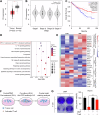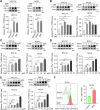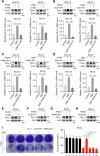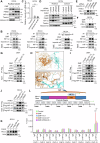Oncometabolite fumarate facilitates PD-L1 expression and immune evasion in clear cell renal cell carcinoma
- PMID: 40461489
- PMCID: PMC12134299
- DOI: 10.1038/s41419-025-07752-4
Oncometabolite fumarate facilitates PD-L1 expression and immune evasion in clear cell renal cell carcinoma
Abstract
Clear cell renal cell carcinoma (ccRCC) is the most common subtype of renal cell carcinoma (RCC), with a rising incidence worldwide. However, the mechanisms by which ccRCC evades immune surveillance remain incompletely understood. Our findings indicate that fumarate hydratase (FH) expression is significantly downregulated in ccRCC, resulting in fumarate accumulation, which is correlated with a poor prognosis in ccRCC patients. RNA sequencing analysis suggests that dimethyl fumarate (DMF), an FDA-approved fumarate analogue, may impact tumor immunity. Our further investigation reveals that both DMF and the FH inhibitor (FHIN1) can promote immune evasion in ccRCC by upregulating PD-L1. Pre-treatment of tumor cells with DMF notably inhibits the cytotoxic effect of T cells. Mechanistically, fumarate induces PD-L1 expression through succination of HIF-1α at C800, facilitating its interaction with importin α3, p300, and PKM2, which promotes HIF-1α nuclear localization and transcriptional activity. Moreover, combining DMF with PD-L1 blockade therapy significantly enhances the efficacy of immunotherapy and prolongs the survival of tumor-bearing mice. Taken together, our study elucidates a mechanism by which FH downregulation promotes immune evasion through the fumarate-HIF-1α/p300/PKM2-PD-L1 axis, providing a novel target, drug, and strategy to improve immunotherapy for ccRCC.
© 2025. The Author(s).
Conflict of interest statement
Competing interests: The authors declare no competing interests.
Figures







Similar articles
-
YTHDF3 phase separation regulates HSPA13-dependent clear cell renal cell carcinoma development and immune evasion.Cancer Sci. 2024 Aug;115(8):2588-2601. doi: 10.1111/cas.16228. Epub 2024 May 29. Cancer Sci. 2024. PMID: 38811341 Free PMC article.
-
Hexokinase HK3-mediated O-GlcNAcylation of EP300: a key regulator of PD-L1 expression and immune evasion in ccRCC.Cell Death Dis. 2024 Aug 23;15(8):613. doi: 10.1038/s41419-024-06921-1. Cell Death Dis. 2024. PMID: 39179546 Free PMC article.
-
Tumor-associated Macrophage-derived Interleukin-23 Interlinks Kidney Cancer Glutamine Addiction with Immune Evasion.Eur Urol. 2019 May;75(5):752-763. doi: 10.1016/j.eururo.2018.09.030. Epub 2018 Oct 4. Eur Urol. 2019. PMID: 30293904
-
PD1/PD-L1 blockade in clear cell renal cell carcinoma: mechanistic insights, clinical efficacy, and future perspectives.Mol Cancer. 2024 Jul 16;23(1):146. doi: 10.1186/s12943-024-02059-y. Mol Cancer. 2024. PMID: 39014460 Free PMC article. Review.
-
Hypoxia, Hypoxia-inducible Transcription Factors, and Renal Cancer.Eur Urol. 2016 Apr;69(4):646-657. doi: 10.1016/j.eururo.2015.08.007. Epub 2015 Aug 19. Eur Urol. 2016. PMID: 26298207 Free PMC article. Review.
Cited by
-
Tumour- and Non-Tumour-Associated Factors That Modulate Response to PD-1/PD-L1 Inhibitors in Non-Small Cell Lung Cancer.Cancers (Basel). 2025 Jun 30;17(13):2199. doi: 10.3390/cancers17132199. Cancers (Basel). 2025. PMID: 40647497 Free PMC article. Review.
References
-
- Larkin J, Goh XY, Vetter M, Pickering L, Swanton C. Epigenetic regulation in RCC: opportunities for therapeutic intervention? Nat Rev Urol. 2012;9:147–55. - PubMed
-
- Zhang X, Li S, He J, Jin Y, Zhang R, Dong W, et al. TET2 suppresses VHL deficiency-driven clear cell renal cell carcinoma by inhibiting HIF signaling. Cancer Res. 2022;82:2097–109. - PubMed
-
- Tumkur Sitaram R, Landstrom M, Roos G, Ljungberg B. Significance of PI3K signalling pathway in clear cell renal cell carcinoma in relation to VHL and HIF status. J Clin Pathol. 2021;74:216–22. - PubMed
MeSH terms
Substances
LinkOut - more resources
Full Text Sources
Medical
Research Materials
Miscellaneous

